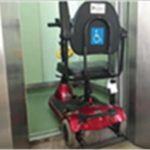Staircases
 Blocked Refuge Areas and Slip and Fall Issues
Blocked Refuge Areas and Slip and Fall Issues
 Wheelchair Inaccessibility on Stairs
Wheelchair Inaccessibility on Stairs
 Accessibility Considerations for Elevators
Accessibility Considerations for Elevators
Staircases are important pedestrian routes between different levels. They often also serve as the means of egress from structures and buildings [1]. Because they are constantly subjected to wear and tear due to human and/or goods transportation traffic, it is vital for personnel overseeing the management of facilities to maintain and inspect them, to ensure safety as well as identify any minor or major damage [2]. The identified defects refer to issues concerning a stairway’s general requirements, handrails, slippery access routes and accessibility. The design of escape staircases should provide all occupants with a safe and efficient exit. Accessible refuge areas are also vital for occupants to evacuate in any emergency [3]. Additional information regarding the accessibility considerations for elevators, although maintainability considerations pertaining to vertical transportation are dealt with in the MEP Systems of the building component category.
References
[1] Campbell, J. W. P. and Tutton, M. eds. (2014). Staircases: History, Repair and Conservation. Campbell, New York: Routledge.
[2] Templer, J. A. (1994). The staircase: studies of hazards, falls and safer design. USA: Massachusetts Institute of Technology.
[3] Singapore Civil Defence Force (2013). Code of Practice for Fire Precautions in Buildings. Singapore: SCDF.
